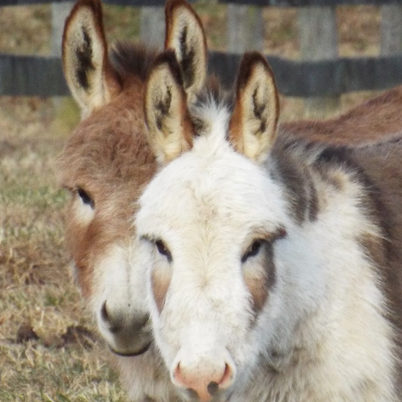I thought we would post a bit about laminitis, which is a disease that affects the feet of hooved animals.
These photos are xrays taken of our poor Sonny, who we recently had to euthanize. He was surrendered to us at age 25, and in terrible pain. This is a very extreme case, and the unfortunate part is that many donkey (and horse) owners DO NOT realize that this is what happens from chronic laminitic episodes. Here is a great article, Laminitis In Donkeys, written by the Donkey Sanctuary in England which may help with your understanding of this disease. Laminitis and founder are complicated issues to fully understand, and we encourage everyone out there to do even more research and ask questions of your vet if you don’t really understand what is going on.
As described in “Laminitis in Donkeys”, “the normal anatomy of the donkey foot depends upon a firm connection between the insensitive hoof wall and the sensitive ‘quick’ (tissue adherent to the pedal or toe bone). This is brought about by both tissues being folded into leaves or ‘laminae’ and interweaved so there is a large surface area in intimate contact (think of it like Velcro) – this is needed to withstand the downward pressure exerted by the weight of the donkey. All that stands between the normal donkey and a ‘foundered’ donkey (rotation or downward movement of the pedal bone) is that vital interlocking of tissue. When this connection is compromised the pedal bone loses its support. Now we understand so much more about this cripplingly painful disease we know that there are several different causes but all result in the same pathology – always painful, seldom reversible and sometimes fatal. Donkeys have a very stoical nature – they do not behave in the same way as horses when they have severe foot pain. A donkey will tend to lie down more than usual or adopt subtle weight shifting as it stands. Just as one’s finger may really throb if it is inflamed/ infected so a donkey’s pulses may be felt either side of the fetlock. The donkey may appear dull and we already know that a dull donkey is a veterinary emergency!”


One of the most important things you can do to save your donkey from a fate like Sonny’s is to create a dry lot for them. This is a paddock area with no grass that you create for them to spend time in so that you can limit their time on the green grass. Where they will eat hay instead. It is part of our adoption criteria, and an absolute MUST if you want to have healthy, happy donkeys in this part of the country. There is simply too much rich grass out here, and donkeys have not adapted well to the ultra rich nutrients found in their grazing lands out here (remember, they are first and foremost, a desert animal).
Just about every donkey that is surrendered to us by a well meaning owner, is obese, and has already foundered and is suffering some measure of foot pain, and the owner does not even realize it. We x-ray every fat donkey that comes to us, and especially all of the donkeys who have not received any farrier care, and not surprisingly, almost all of them have some rotation of the coffin bone.
We would love to adopt out even more donkeys this year, but we find that time and time again, people are unwilling to build and create a dry lot area for their donkeys, or they simply do not believe us that it is necessary for their long term health and soundness. We just don’t know how else to say it, but if you have a donkey, and it is living on pasture, and you don’t regulate, or limit how much pasture it is eating (in this part of the country, where grass is nice and rich), your donkey will likely founder at some point. Please take the extra steps necessary to create the best possible environment for your donkeys, and create a drylot for them. Then you can adopt from us too!
